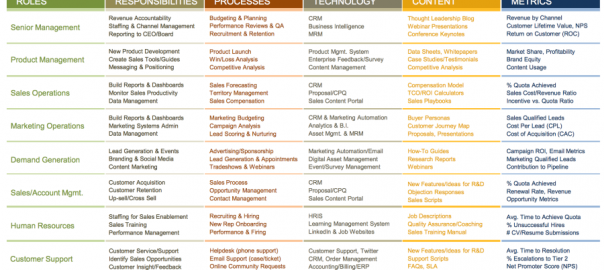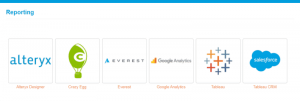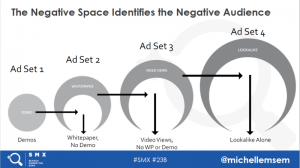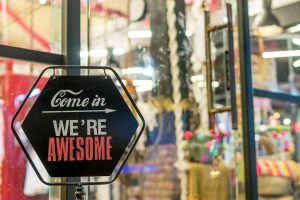August 4, 2016
What if I told you there’s one thing that you can do right now as a sales leader that will help you achieve higher team quota attainment, more revenue growth, higher sales velocity, and increase in lead conversion rate?
It’s not a magic new magic sales methodology and it has nothing to do with a new tool or technology.
This one thing that can change the course of your business is Sales Enablement.
In his book To Sell is Human, Dan Pink explains that sales has changed more in the last 10 years than in the last 100. However, this is wrong, and the reality is that the buyer has changed (especially in a complex B2B environment). Sales is only now catching up thanks to sales enablement.
Research by Aberdeen reveals that sales enablement leads to 62% higher team quota attainment, 205% more revenue growth, 725% higher sales velocity, and 23% increase in lead conversion rate in organizations with structured sales enablement programs versus organizations without it. That’s how powerful it is.
It’s clear that sales enablement is a sales driver, not just a nice-to-have. Many high growth companies are deploying this function with incredible results, as they jump on the opportunity to supercharge the revenue-generating side of the business. However, other companies are laggards, and they suffer the consequences.
Where does your company stand?
The Rise of Sales Enablement
Sales Enablement is an evolution of sales ops and marketing but elevated to a more strategic, proactive and hands-on level. With more tools, more resources, and a more complex sales process, you need a person or department who owns this and can deliver it to sales reps.
There’s no single agreed upon definition of sales enablement, as it’s still maturing and evolving in function and scope, but I like the definitions from David Brock in his new groundbreaking book The Sales Manager’s Survival Guide: “It’s all about providing tools, systems, processes, training, coaching, and development that ‘enables’ sales to be more effective and efficient.”
Though the responsibilities of sales enablement is still being defined, we can begin to clarify its scope. The following four functions are critical for a successful sales enablement program:
- Content: Sales enablement must make sure that quality content is created and sales reps can find and utilize the right content at the right time.
- Training: Reps must be trained in not only sales skills, but product, marketing/industry and business skills as well.
- Tools and Technology: Once the strategy is established, you must guarantee adoption of the technology to execute against the process. This function also overlaps with training, as tools and technology add functionality and become more complex.
- Strategy and Execution: Sales enablement goes beyond winning deals and extends to hiring and onboarding, forecasting, budgeting, and performance reviews.
Most sales leaders and practitioners agree you need a full-time sales enablement function once your team hits a certain size. The size varies depending on the complexity of the sale and the maturity of the market, but the consensus is that you need to pull the trigger and form a department somewhere between 50 and 75 sales reps.
If you’re a smaller organization, you may not need a dedicated team full time, but it’s highly recommended that you get someone who’s responsible for this function. Sometimes responsibility falls under sales ops or sales management, yet other time I’ve seen the responsibility placed on marketing ops or product marketing.
The job of a salesperson is to show up on a call (or meeting) knowledgeable, skillful and with the right assets to help prospects buy. If there’s any indication that any of these elements are not there, you need to invest in sales enablement now. These gaps in efficiency and effectiveness are robbing your company of money.
Here’s the bottom line: You’re never too small to have a sales enablement program.
The Critical Components of a Successful Sales Enablement Program
When you ask about the importance of those critical components in sales that are under the enablement umbrella, there’s a Grand Canyon-sized gap between how important companies rate those activities and how they rate their current efforts.
Let’s dive into each of these aspects a little more.
Content: There’s evidence that the sales enablement function grew largely out of the need for sales reps to leverage and optimize the content that marketing was creating. The two problems that needed to be solved were quality/value and discovery/utility. There’s an overwhelming about of mediocre content on the web. By creating more valuable content, you’re helping reps stand out in the noise, establish expertise, and build trust with prospects faster.
When it comes to discovery/utility, among the many studies conducted, they all agree on one thing: less than 60% of the content being created for sales is not being used. This is in large part because either the content is not easily accessible and discoverable, or reps simply don’t know the most appropriate time to use which content. It’s sales enablement’s job to make sure the right content is being created and reps can find and use said content.
Ultimately, content’s job is to drive more deals. We already wrote about the four ways that sales enablement can help with content, but here’s a quick recap.
- Reusable Templates for Proposals, Quotes, and Contracts: Creating templates the entire sales team not only saves hours of writing content from scratch, it also creates consistent messaging.
- Beat Out the Competition with Battle Cards: A battle card is any type of content that educates and differentiates you from your competitors. This gives your sales team fuel to keep the deal moving forward.
- Let Your Customers Become An Additional Salesforce: What your customers say about you can be 10 times more powerful than what you say about yourself. Get case studies that speak to every type of customer you have, whether it’s by industry, company size, or specific use case.
- Optimize Content Utilization By Diversifying Your Channels: With all the different channels to promote content — from email and phone to social and direct channels — you must be everywhere your prospects are to stay top of mind. It takes a joint effort from sales and marketing to execute this.
Training: This goes much further than training for sales skills. It’s sales enablement’s job to ensure product knowledge with product training, assess marketing information for relevant industry training, and establish project management for critical thinking. Not to mention it’s their job to guarantee reinforcement as well. The fatal flaw that most organizations suffer from regarding training is it happens only once per year. What’s the good of investing time, money and energy in training if it’s not reinforced?
There’s a distinction that needs to be made between training and coaching. Coaching is about personal and professional development, and it deals with real situation and behaviors that are unique to each individual rep. Training develops the same skills and capabilities for everyone and should be standardized across your entire sales team. Coaching is done by managers. Training should leverage the sales enablement program.
David Brock, President of Partners In EXCELLENCE and author of The Sales Manager’s Survival Guide, emphasized that there are so many other things that are important to the success of your team beyond sales skills training. Your sales enablement program should also include the following
- Product training (monthly)
- Sales training (monthly)
- Tools/technology training (quarterly)
- Market and industry training (quarterly)
- Change management/project management (quarterly)
- Critical thinking and problem solving (quarterly)
Tools and Technology: This should be the last piece of the puzzle because tools are just a means to get a job done and execute a process. It never starts with the technology, as it just supplements a reps abilities and behaviors. Always start with process first, and technology will follow. Too many organizations get caught up letting the tail wag the dog.
Once the process is established, it’s also sales enablement’s job to guarantee adoption of the technology to execute against the process. This function also overlaps with training, as tools and technology add functionality and become more complex.
The key categories of technology that sales enablement will influence are CRM, marketing automation, sales intelligence and automation, communication solutions, CPQ (configure, price quote) and content/knowledge management.
Here are the major things to keep in mind when setting up your technology stack to make your sales team more effective and efficient:
- The technology is for your salespeople first and foremost, not you.
- Regularly use the tools yourself, and observe your sales team use them as well.
- Tools and technologies only supplements and often augments a reps abilities and behaviors, both good and bad.
- The amount and variety of tools in the tech stack can become counterproductive. Don’t go overboard.
Strategy and Execution: As you can tell, there are a lot of moving parts and sales enablement touches and influences. With the broader vision and company goals set by the c-suite, sales leadership is beginning to pull sales enablement in to help define the strategy and steps to increase efficiency and effectiveness from their reps. However, the breadth of influence sales enablement has gone beyond winning deals and extends to hiring and onboarding, forecasting, budgeting, and performance reviews.
Demand Metrics put together one of the best charts that help visualize and conceptualize sales enablement and the execution against the strategy in their Sales Enablement Best Practices Report (2014).
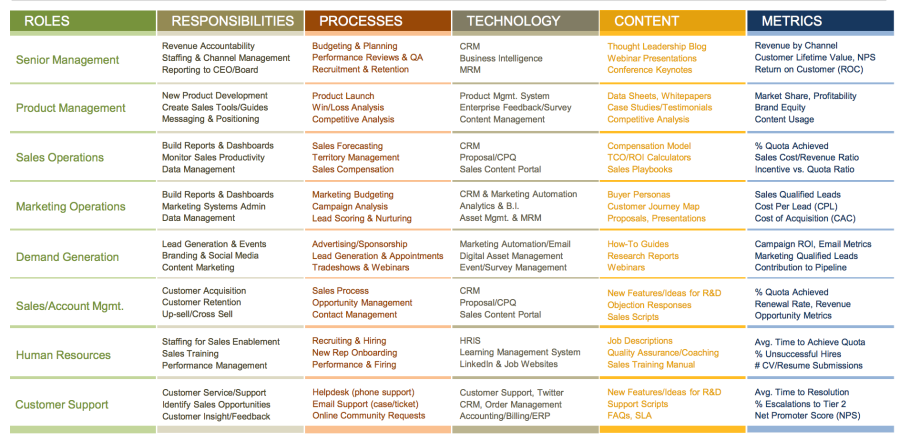
5 Steps to Setting Up Your Sales Enablement Program
Whether you’re a large team of 500+ sales reps or a small team of five, having a sales enablement program is critical for success. You can use these five steps to set up a program or tighten up your existing program.
1) Know your objectives. You must be very clear on the outcomes that you want. “Increasing revenue” or “generating more pipeline” isn’t good enough. The most important numbers to sales teams are pipeline, revenue, and customer lifetime value. However, Matt Heinz argues for a different metric for measuring sales enablement effectiveness: active selling time (expressed as a percent of a rep’s entire day). Another significant metric to measure is time to quota (expressed in months). Effective programs can shorten ramp time where new reps are matching quota attainment for the rest of your team months sooner.
When it comes to objectives and goal setting, I always advocate for SMART goals; goals that are Specific, Measurable, Achievable, Realistic and Timely. You must be scientific and methodical as possible so you can determine if your program is actually getting results.
2) Talk to the people closest to the problem. This starts with understanding the problem that you’re trying to solve, and what better way to accomplish that than talking with the people in the trenches day in and day out? Don’t forget to get an opinion from marketing, sales ops, account management, customer success and anyone who will be affected. Second order effects/benefit of talking to your reps is that their active participation in this process always results in better adoption and buy-in of practices established.
3) Know your buyer and their journey. Since we’ve already established that the ultimate goal is to deliver the best experience to a prospect or buyer, you must first know them inside and out. Beyond knowing their pain points and challenges, you must be able to recognize buying signals and trigger events that are related to that prospect’s problems.
I’ve addressed ideal client profiles and buyer personas many times before, which serves to reinforce its importance. It’s the cornerstone of other critical programs like outbound sales campaign management and account-based sales development strategy.
4) Maps the sales process to your buyer’s journey. When sales leaders are planning their strategy, it’s common for them to only focus on what’s best for their team and neglect the customer. The paradox is that what’s best for the sales team starts with that’s best for the customer. So rather than focusing on the sales process alone, it’s important to first look at the buyer’s journey and the experience a buyer has with you at every single state of the sales funnel. What’s their internal process for buying? Who needs to be involved? What information do they need? How do they get internal buy in? What are their attitudes and behaviors towards you and the field? Once you understand that, you can begin to understand how to empower your team and deliver a better experience to prospects
5) Validate, iterate, and improve. This is all about holding your sales enablement program accountable. A big reason why the sales space has taken off like a rocket in the last few years is that you’re able to measure performance and adjust. The most effective team’s test content, tactics and execution, but what makes them effective is rigorously measuring against your goals. You need a reporting structure to measure effectiveness, not to mention clear, objective standards and definitions for success.
No more fly-by-the-seat-of-your-pants selling. No random acts of sales enablement allowed. It would be humorous yet tragic if the sales enablement function (who is tasked with making sales more effective and efficient) wasn’t effective and efficient itself. It would be humorous yet tragic if the sales enablement function (who is tasked with making sales more effective and efficient) wasn’t effective and efficient itself.
Conclusion
Adopting a sales enablement program will dramatically impact your sales team and how effective they are at closing deals.
Though the function and scope of sales enablement is still evolving and being defined, there is one thing that we can all agree on – sales enablement should be a mindset. Once everyone truly understands this, you can begin to impact the bottom line in a major way.
This is just an introductory overview of sales enablement that only scratches the surface. If you’re really serious about taking your sales game to the next level by making your team more effective and efficient, you’re in luck. We’ve teamed up with the experts at PandaDoc for a webinar that dives into “How to Use Sales Enablement to Increase Pipeline and Drive Revenue.”
Business & Finance Articles on Business 2 Community(113)
Report Post